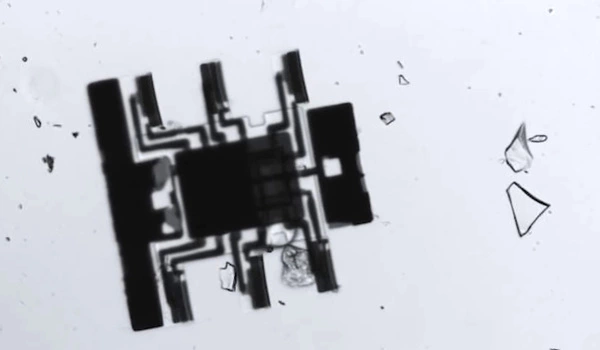Cornell University researchers installed electronic “brains” on solar-powered robots 100 to 250 micrometers in size – smaller than an ant’s head – so that they can walk autonomously without being controlled externally.
While Cornell researchers and others have previously developed microscopic machines that can crawl, swim, walk, and fold themselves up, there were always “strings” attached; to generate motion, wires were used to provide electrical current or laser beams had to be focused directly onto specific locations on the robots.
“Previously, we literally had to manipulate these’strings’ in order to get any kind of response from the robot,” said Itai Cohen, a physics professor. “But now that we have these brains on board, it’s like taking the strings off the marionette. It’s similar to when Pinocchio awakens.”
The breakthrough pave the way for a new generation of microscopic devices that can track bacteria, sniff out chemicals, destroy pollutants, perform microsurgery, and scrub plaque out of arteries.
What this allows you to imagine is really complex, highly functional microscopic robots with a high degree of programmability, integrated with both actuators and sensors. We’re excited about the applications in medicine — something that could move around in tissue and identify good cells and kill bad cells and in environmental remediation, such as if you had a robot that could break down pollutants or sense a dangerous chemical and get rid of it.
Itai Cohen
The project brought together researchers from the labs of Cohen, Alyosha Molnar, associate professor of electrical and computer engineering; and Paul McEuen, professor of physical science, all co-senior authors on the paper. The lead author is postdoctoral researcher Michael Reynolds.
The paper, “Microscopic Robots with Onboard Digital Control,” was published in Science Robotics.
The “brain” of the new robots is a complementary metal-oxide-semiconductor (CMOS) clock circuit with a thousand transistors and an array of diodes, resistors, and capacitors. The integrated CMOS circuit generates a signal that generates a series of phase-shifted square wave frequencies, which in turn set the robot’s gait. The robot legs are made of platinum-based actuators. Photovoltaics are used to power both the circuit and the legs.

“Eventually, the ability to communicate a command will allow us to give the robot instructions, and the internal brain will figure out how to carry them out,” Cohen said. “Then we’re having a conversation with the robot. The robot might tell us something about its surroundings, and we might respond by telling it, ‘OK, go over there and try to figure out what’s going on.'”
The new robots are 10,000 times smaller than macroscale robots with onboard CMOS electronics and can walk at speeds faster than 10 micrometers per second.
Reynolds’ design of a fabrication process, which essentially involves customizing foundry-built electronics, has resulted in a platform that allows other researchers to outfit microscopic robots with their own apps, ranging from chemical detectors to photovoltaic “eyes” that aid robot navigation by sensing changes in light.
“What this allows you to imagine is really complex, highly functional microscopic robots with a high degree of programmability, integrated with both actuators and sensors,” Reynolds said. “We’re excited about the applications in medicine — something that could move around in tissue and identify good cells and kill bad cells – and in environmental remediation, such as if you had a robot that could break down pollutants or sense a dangerous chemical and get rid of it.”















